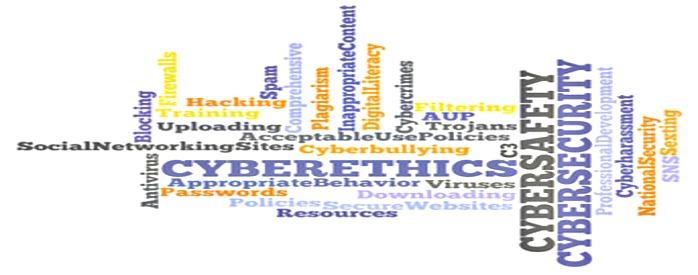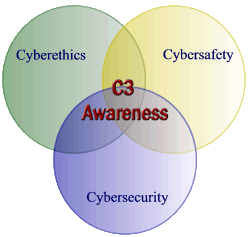 |
|
Cyberethics, Cybersafety and CyberSecurity (C3®) AwarenessWe inform the educational community about Cyberethical, Cybersafety and CyberSecurity implications of technology use and illustrate how students, educators and parents can apply these concepts to their own setting. C3 OverviewPromoting responsible use of technology is not a new phenomenon in education. It has been branded by a variety of stakeholders as digital citizenship, cyberawareness, and cybercitizenship. Existing strategies of instruction include detailing student, teacher, and administration standards and restrictions in Acceptable Use Policies and student handbooks. Additionally, IT departments have installed Internet filtering and blocking software within state and local education agencies to ensure students’ safe and secure technology use. However, some argue that having rules in handbooks and blocking/filtering content is not equivalent to safe behavior instruction. Students need to understand the “why” behind the rules, and be able to institute best practices within their normal activities. Once students leave the school and are using unblocked open systems, they are left unprotected and are not able to make the distinction between safe and dangerous activities. Additionally, often school policies and instruction are uncoordinated and do not include all Cyberethics, Cybersafety, and CyberSecurity (C3) topics because state and local education agency standards use broad-stroke statements to guide curriculum and competency. Interpretations of these standards or guidelines have in some cases missed the mark related to C3 issues and how they correlate with human behavior. Ethics is intended to represent personal choice. Using the analogy of riding a bicycle, ethically we choose not to ride on our neighbors grass. Safety refers to safe practices, i.e. ride on the right side of the road, and obey traffic laws. Security refers to additional items we have to do, for example adjust gears and brakes. The first is a moral choice, the second is the way we behave, and the third requires further action, and each operates at a different cognitive level and therefore needs to be broached differently. Clearly there is overlap between each, however, the subject matter and instructional approaches needed are different and are important to address. The presence of a holistic policy framework can strengthen the already positive directions made by Internet safety providers, education entities and state attorney general offices. Adopting a policy framework adds the potential to broaden the impact on students, teachers, and parents in addressing ALL areas determined by government, business and industry, health agencies, and education to be of increasing importance. This C3 model was originally conceived in 2000, and has been embraced and adopted by CyberWatch, the National Cyber Security Alliance, and several Internet safety providers and state educational agencies to guide the design of their policies, recommendations, and content. The C3 theoretical framework can be used to inform a national, regional, or local agenda. Its three dimensions are based on practical circumstances and experiences with educating students and teachers, with input from multiple stakeholders including parents, students, educators, technology coordinators, media specialists, curriculum resource teachers, Internet safety providers, and industry security specialists and serve as a basis for behavioral change. The logo with its overlapping rings of Cyberethics, Cybersafety, and CyberSecurity indicates the subject areas have common ground, but also have significant differences that must be discussed separately, including both subject matter and psychological differences.
|
|
 |